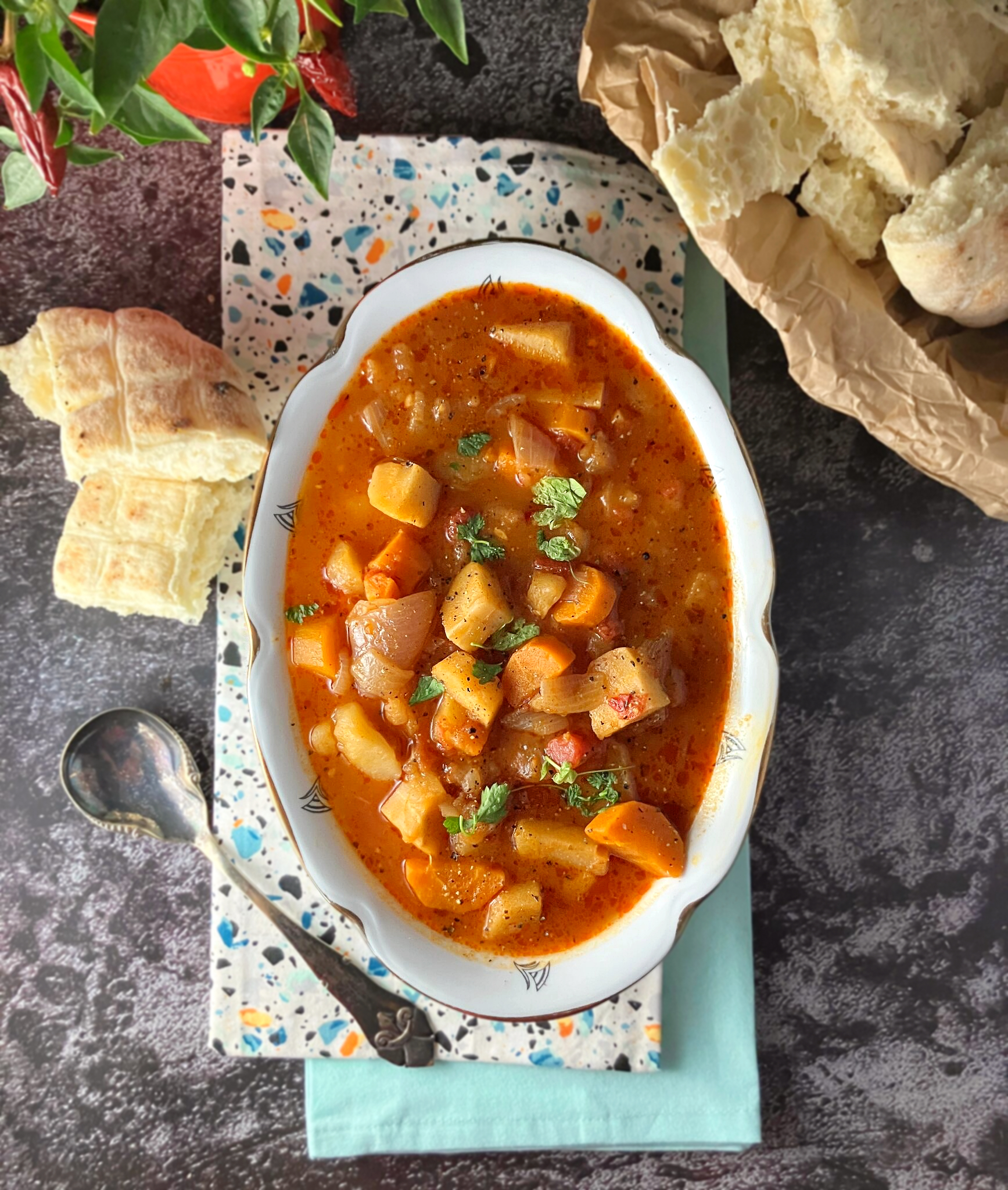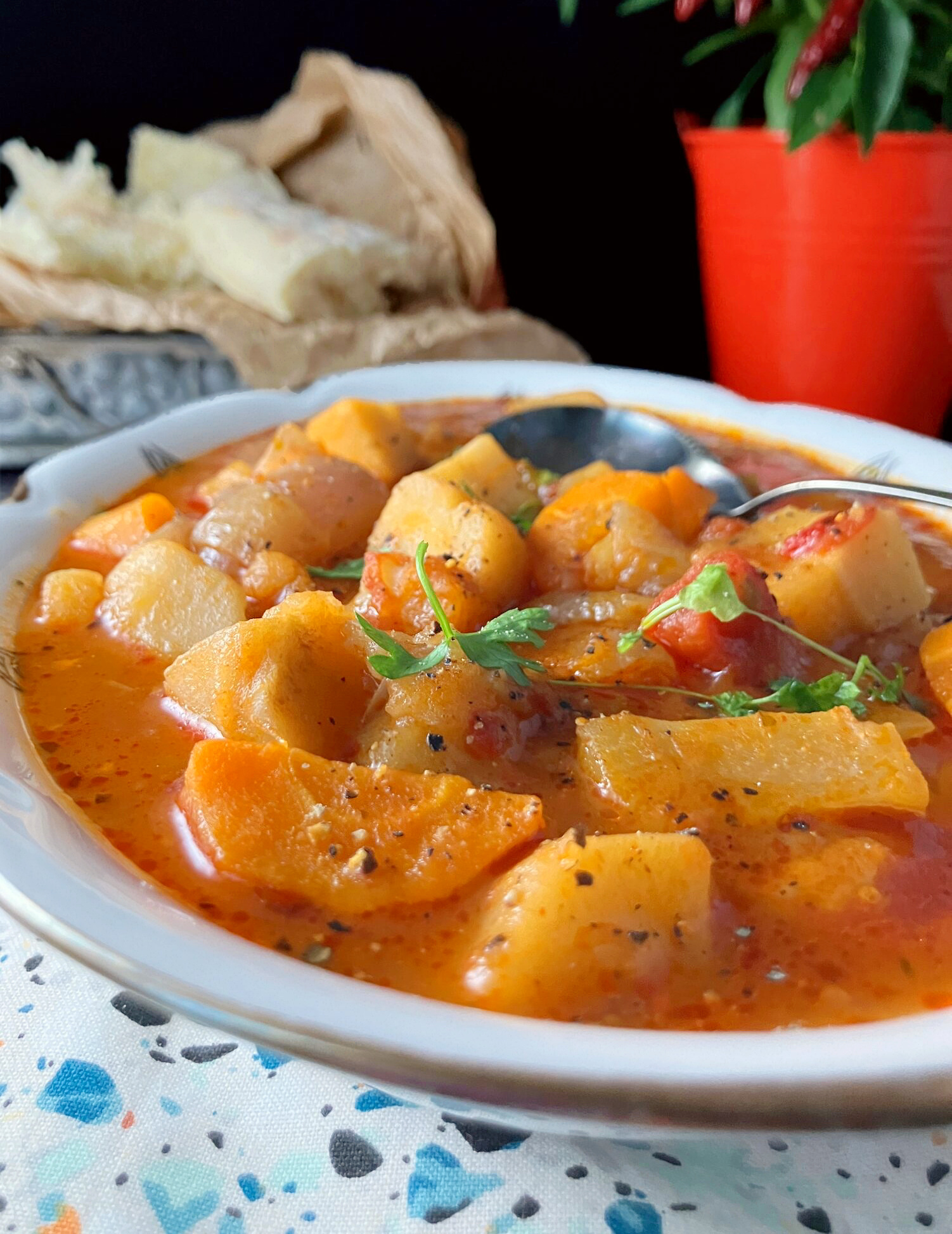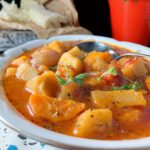Winter Vegetable Paprika Stew
This was so good! Definitely will make again!
★★★★★
This winter vegetable paprika stew is filling, economical, and tasty. The perfect hearty meal for a cold winter’s evening, it is made with carrots, swede, potatoes, onions and parsnip, but you can add anything you like.

This winter vegetable paprika stew is just the thing as the cold, dark nights draw in.
I work full time and often feel little motivation to cook a healthy meal when I come home. But I also crave filling, warming food when the winter falls. Although this stew needs some preparation (mainly peeling vegetables) once that’s finished, it can be left to cook unattended. This means you can sit down with a nice glass of wine (or two) and chill while it cooks.
What’s the difference between turnips, swedes and rutabagas?
Ah. This question is not as simple as it may first appear.
Swedes and rutabagas are the exact same thing. They are a hardy vegetable, with a rough skin and yellow flesh. The name swede (which comes from Swedish turnip) is used in most commonwealth countries. In North America, it is known as rutabaga.
Turnips are much smaller and softer with white flesh. Although part of the same family, turnips are quite different. However, despite this, many areas in the UK refer to a swede as a turnip.
The discovery of swede/rutabaga goes back to 1620, when a Swiss botanist noticing them growing wild in Sweden. Although we know the swede arrived on British shores at the end of the 18th century, how it happened, we are not entirely sure. Some say that it was introduced from Germany, while others say its seeds were brought as a gift by a Swedish king. It didn’t take long for swedes to land in the USA, with the earliest mention recorded early in the 19th century. Along with its introduction to the USA came a new name: rutabaga, which is taken from the Swedish word rotabagge.
Here in Sweden, they are called kålrot (directly translated as cabbage root), which is an umbrella term for both swedes/rutabagas and turnips.
Which winter vegetables work in this stew?
I have added parsnip, carrot, swede (rutabaga), onions and potatoes. However, you can use whatever vegetables you like. Good alternatives (or additions) would be yams, sweet potatoes, turnips, kohlrabi, and Brussel sprouts. Nothing is off limits, though. Whatever you have in the back of your fridge crying to be used up, just throw it in.
Can you add meat to the stew?
Yes, of course. I have been a pescatarian for four years, but many of my earlier recipes include meat. Although this recipe is filling enough on its own (especially with some bread) and really doesn’t need any meat, you could stir in some shredded chicken five minutes before serving, or fry off some meat with the onions. Alternatively, my slow-cooked beef and tomato stew is to die for, so perhaps try that, instead?
What can I serve with this winter vegetable paprika stew?
Lashings and lashings of bread. Don’t forget the butter. The sauce is fairly thin and needs a good old wedge of bread to soak up all the goodness.
Soft breads like my cheese and garlic loaf or my super soft bread buns would work like a dream. Or, alternatively, why not try a crusty, healthier loaf like my seeded rye loaf and wholemeal soda bread?
More simple winter meals (made from scratch)
There is nothing cozier than a warm, delicious, homemade dinner. However, like I’ve already said, the motivation can seriously be lacking to make it. Here are some of my favourite, easy to make winter meals:
- Creamy chilli prawn and fish noodles (ready in 30 minutes)
- Sweet potato, leek and garlic soup
- Spinach and ricotta lasagna rolls
- Spicy roasted vine tomato soup
- Mushroom stroganoff (30 minute meal)
- Red peppar chilli sin carne (veggie chilli)
- No meat tortilla bake with peppers and onions
Winter Vegetable Paprika Stew
Ingredients
- 30g (2⅛ tbs) butter
- 2 tbs olive oil
- 2 red onions (chopped into large chunks)
- 2 onions (chopped into large chunks) - see note 1
- 1 small chilli pepper (finely chopped)
- 1 tsp minced garlic
- 250g (8¾ oz) carrots (chopped into thick slices)
- 250g (8¾ oz) swede (chopped into chunks)
- 150g (5¼ oz) parsnip (chopped into small chunks)
- 800g (28 oz) potatoes (cut into large chunks)
- 400g (14 oz) tinned (canned) chopped tomatoes
- ¼ tsp cinnamon
- 2 tbs ground paprika
- 1 tsp oregano
- sea salt (to taste)
- ground black pepper (to taste)
- 1 tbs wine (optional)
- 1000ml (4¼ cups) water (or stock)
- sprinkling of fresh herbs (optional)
Instructions
- Add the butter and oil to a large pan.
- Cook the onions and chilli pepper until soft.
- Add the garlic and cook for a minute or two.
- Add the cinnamon, paprika and oregano, sea salt and black pepper.
- Add the wine (if using) and cook until it evaporates (only a minute or two).
- Add the tomatoes and water / stock.
- Stir so that everything is well mixed and leave to cook for a couple of hours on a slow heat. The stew is ready when the sauce thickens and the vegetables are cooked through.
- Serve immediately with a sprinkling of fresh herbs and a good helping of bread. Enjoy!
Notes
- Onions refer to what North Americans would call yellow onions.
- The measurements for the vegetables are approximate, so use them as a rough guide (neither the ingredients nor the quantities need to be exact).
- The vegetables are cut into different sizes, depending on how quickly they cook. This means that they should all be cooked at pretty much the same time.
2 thoughts on “Winter Vegetable Paprika Stew”
Leave a Reply




This was so good! Definitely will make again!
Thank you, Vanessa! One of my favourites, too!